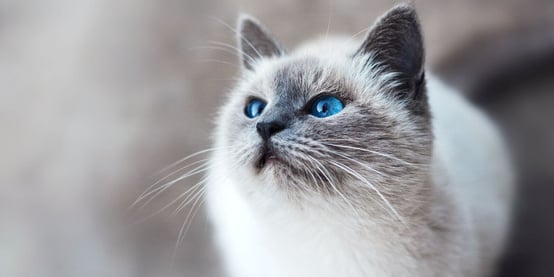No pet parent wants to think about the possibility of creepy-crawlies contributing to their pet’s medical issues. But this is the unfortunate reality of hookworms – a common intestinal parasite that can cause uncomfortable symptoms.
Hookworms can affect cats, dogs, and other animals. Fortunately, hookworms tend to be less aggressive in cats, and are most likely to occur in heavily wooded areas. That said, it’s not impossible for cats to get infected in other types of environments.
It’s best to be educated about the signs of hookworms so you can identify (and treat) the symptoms right away. In this guide, we are covering the signs of hookworms in cats and what steps to take if your pet is infected.
What are Hookworms?
.png?width=1600&height=800&name=hookworms%20in%20cats%202%20(1).png)
Photo by Raul Varzar on Unsplash
Hookworms are intestinal parasites. These parasites (scientifically known as Ancylostoma spp. and Uncinaria spp.) are small, thin worms that attach to the lining of the cat's intestinal tract, specifically the small intestine.
How Cats Contract Hookworms
Hookworm infections typically occur through ingestion or skin penetration of larvae present in contaminated environments, such as soil or feces. Kittens can also contract hookworms from their mother's milk.
Here are some additional situations in which a cat might contract hookworm:
- Walking or playing in contaminated outdoor areas: Cats that spend time outdoors, particularly in environments where other infected animals frequently defecate, such as parks, gardens, or communal spaces, are at risk of picking up hookworm larvae through contact with contaminated soil or sand.
- Living in unhygienic conditions: Cats residing in areas with poor sanitation, including places with fecal contamination or inadequate waste disposal, might easily contract hookworms due to the prevalence of larvae in the environment.
- Contact with infected animals: Cats that come into contact with other animals carrying hookworms, especially in shelters, catteries, or multi-pet households where there might be a higher likelihood of parasites, are at risk of infection through shared spaces or direct contact.
- Ingesting contaminated prey: Cats that hunt and consume rodents, birds, or other small animals infected with hookworm larvae can become infected themselves by ingesting the parasitic larvae.
- Contaminated water sources: Drinking water from sources contaminated with hookworm larvae can lead to infection in cats. This can occur in areas where water sources are not adequately treated or where there's runoff from contaminated soil.
It’s also important to note that hookworms can be passed from animal feces to humans. This is even more reason to identify and treat hookworms as soon as possible.
How to Identify Hookworms
.png?width=1600&height=800&name=hookworms%20in%20cats%203%20(1).png)
Photo by Kim Davies on Unsplash
Hookworm symptoms can be similar to symptoms of other illnesses and conditions. So, if your cat is exhibiting any of these symptoms, the best course of action is to contact a veterinarian for an accurate diagnosis.
Look out for the following symptoms and be sure to describe them to your trusted veterinarian.
Hookworm Symptoms:
- Skin Irritation: Redness, pain, and itching, skin irritation, or lesions can occur due to the larvae penetrating the skin.
- Gastrointestinal Issues: Cats infected with hookworms may experience symptoms like stomach pain, nausea, diarrhea, weight loss, vomiting, and poor appetite.
- Anemia: Hookworms feed on the blood of the host, which can lead to anemia, especially in young or debilitated cats. Anemic cats may exhibit weakness, lethargy, and pale gums.
- Coughing: If the hookworm larvae migrate through the respiratory tract or are coughed up and then swallowed, it can lead to coughing in infected cats.
- Potbellied appearance: Severe hookworm infestations can cause abdominal swelling or a distended abdomen in cats, giving them a “potbellied” appearance. This occurs due to the accumulation of fluid in the abdomen (ascites) caused by the damage to the intestinal lining and subsequent leakage of fluids into the abdominal cavity.
- Lethargy and weakness: Anemic cats may display symptoms such as lethargy, weakness, and decreased activity levels due to the loss of blood caused by hookworms.
- Dark or tarry stools: The presence of blood in the stool can give it a dark, tarry appearance (melena). This occurs as a result of the hookworms feeding on the blood within the intestinal tract.
Complications Caused by Hookworms
Young kittens are particularly susceptible to hookworm infections, often acquiring them from their mother's milk or through contact with contaminated environments. Kittens that are heavily infested with hookworms may exhibit stunted growth or fail to thrive due to the nutritional deficiencies caused by these parasites.
.png?width=1600&height=800&name=hookworms%20in%20cats%204%20(1).png)
Photo by Lisa Algra on Unsplash
While hookworm infections are not always severe and may go unnoticed in some cats, they can cause health issues, particularly in young, elderly, or immunocompromised cats. Cats suffering from hookworm infections might have a dull-looking coat, digestion issues, skin infections, or more serious illnesses due to the effects of anemia and nutrient deficiencies.
Also, humans can contract hookworms from their pets by inadvertently being exposed to their feces. Humans infected with hookworms can exhibit symptoms such as skin irritation, gastrointestinal issues, weight loss, and anemia.
It's important to note that the severity of symptoms can vary based on the cat's age, overall health, and the extent of the hookworm infestation. Some infected cats may not display obvious symptoms initially, while others might exhibit more severe clinical signs.
How to Treat Hookworms
Do not attempt to treat hookworms - or any parasite - without first consulting a veterinarian. They will be able to provide the recommended course for treatment based on your pet’s age, health status, etc. Be sure to relay the symptoms or warning signs to your vet.
The treatment for hookworm infections typically involves the use of specific medications known as anthelmintics that target and eliminate the parasites. The choice of medication and treatment duration may vary based on the severity of the infection, the species of hookworm involved, and individual health factors.
.png?width=1600&height=800&name=hookworms%20in%20cats%205%20(1).png)
Photo by Marco Giuseppe on Unsplash
Veterinarians often prescribe deworming medications specifically formulated to eradicate intestinal parasites like hookworms in cats. Commonly used medications include fenbendazole, pyrantel pamoate, milbemycin oxime, or other anthelmintics.
If your cat is showing severe symptoms, take them to an emergency veterinarian. It is best to diagnose the issue as early as possible in order to avoid more serious complications.
Can You Prevent Hookworms in Cats?
There are many sneaky ways that cats can inadvertently ingest or come into contact with hookworm larvae. That’s why the best “treatment” for hookworms is to prevent an infestation from occurring.
Here are a few steps you can take to try and prevent hookworms:
- Maintain good hygiene by regularly cleaning and disinfecting litter boxes and living areas
- Administer preventive deworming medications as recommended by a veterinarian
- Minimize your cat's exposure to contaminated environments, especially where other animals defecate
- Keep your cat indoors or supervise outdoor activities to reduce contact with soil or sand that may harbor hookworm larvae
- Practice regular veterinary check-ups and fecal exams to detect and treat any potential parasitic infections early
- Dispose of cat feces promptly and appropriately to prevent environmental contamination
- Avoid feeding your cat raw or undercooked meat that could potentially carry parasites
- Wash your hands thoroughly after handling soil, sand, or handling your cat, especially before eating or preparing food
- Consider preventive measures for all pets in multi-pet households to minimize the risk of transmission between animals.
Regular deworming, proper hygiene practices, and minimizing exposure to contaminated environments can help reduce the risk of hookworm infection in cats.
Pet Insurance Coverage for Cat Illnesses
A hookworm diagnosis can be a stressful experience, especially if your cat is severely ill and requires extensive treatment. With that, you might expect the emergency vet bills to add up. Fortunately, pet insurance might be able to help mitigate the costs of an unexpected hookworm infection.
Furkin Pet Insurance offers coverage for up to 80% of eligible expenses associated with unexpected illness, injury, or surgery. With pet insurance, you don’t have to choose between quality pet care and saving money. Make the best decision for your pet and get started with pet insurance today.



